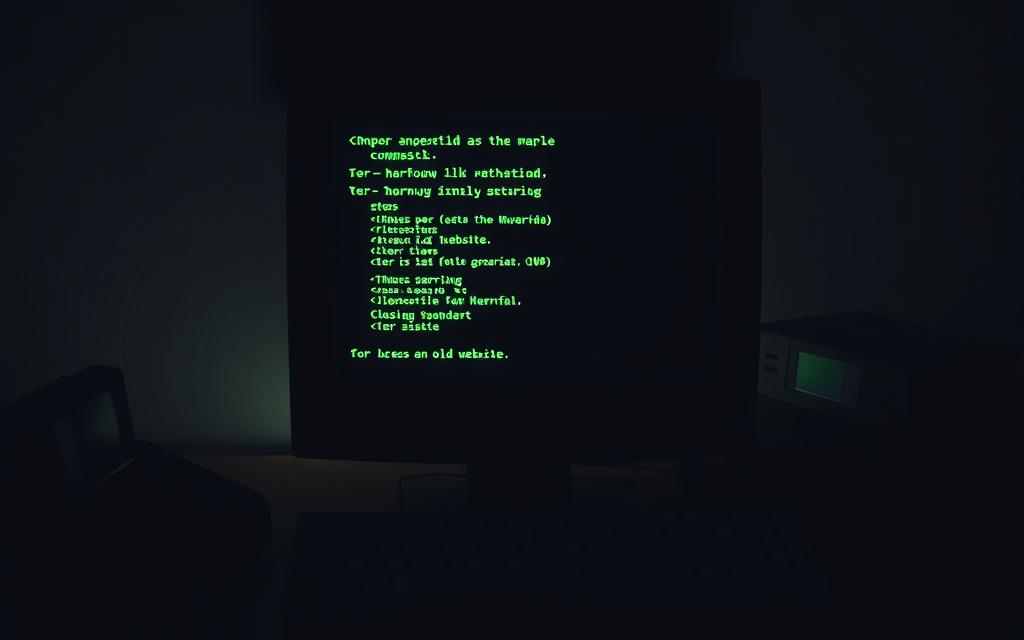Table of Contents
The Command Prompt (CMD) on Windows PCs is a powerful tool for accessing old websites. It can help with sites that don’t work in modern browsers. CMD isn’t a browser, but it can launch your default one and navigate to specific web addresses.
This method is useful for websites incompatible with newer browsers. It’s also helpful when troubleshooting network connectivity issues.
We’ll explore methods and commands for accessing old websites through CMD on Windows. You’ll learn advanced techniques for managing DNS cache and using alternative text-based browsers. These skills will help you access challenging websites from your command line.
Understanding Command Prompt and Website Access Basics
Command Prompt, or CMD, is a powerful Windows tool. It lets users interact with their system through text commands. CMD offers useful features for accessing websites without a browser.
What is Command Prompt and its Role in Web Access
Command Prompt is a text-based interface for executing system commands. It can test network connectivity, manage files, and access websites directly.
Key Command Prompt Features for Website Navigation
- The
pingcommand tests website connectivity and response time. It’s helpful for troubleshooting connection issues. - Browser-specific commands launch a web browser and open a website directly from Command Prompt.
- The
cdcommand navigates to a web browser’s directory for more efficient command execution.
Basic Command Syntax for Web Access
To access websites using Command Prompt, use the start command. Follow it with the browser name and website URL.
start chrome https://www.google.com/start firefox https://www.google.com/
You can also navigate to the browser’s directory first. Then, execute the browser file with the website URL.
cd C:\Program Files\Google\Chrome\Applicationchrome.exe https://www.google.com/
Learning Command Prompt basics gives you more control over website navigation. It also helps with troubleshooting and improves your overall computing experience.
| Command | Description |
|---|---|
ping |
Tests the connectivity and response time of a website or web server |
start chrome https://www.google.com/ |
Launches the Chrome web browser and navigates to the specified website |
start firefox https://www.google.com/ |
Launches the Firefox web browser and navigates to the specified website |
cd C:\Program Files\Google\Chrome\Application |
Navigates to the directory where the Chrome web browser is installed |
chrome.exe https://www.google.com/ |
Launches the Chrome web browser and navigates to the specified website |
Essential Command Prompt Commands for Website Access
The Command Prompt (CMD) on your PC offers powerful web navigation tools. It provides commands for quick website access, browser launching, and URL connection management. Let’s explore some key CMD web commands to boost your online experience.
The ‘start’ command opens your default browser and loads a specific URL. Type ‘start https://www.google.com’ to open Google’s homepage. For Chrome, use ‘start chrome https://www.example.com’ to open a site.
The ‘explorer’ command opens Windows File Explorer. It’s useful for accessing browser settings and configuration files. On macOS, the ‘open’ command serves a similar purpose.
The ‘rundll32’ command offers a unique way to access websites. Use ‘rundll32 url.dll,FileProtocolHandler https://www.google.com’ to open a URL without a browser.
- The ‘start’ command launches your default web browser and navigates to a specific URL.
- The ‘explorer’ command opens the Windows File Explorer, allowing you to access browser-specific settings and files.
- The ‘open’ command on macOS serves a similar function, opening websites and applications from the command line.
- The ‘rundll32’ command provides a direct way to access URLs without using a web browser.
Mastering these CMD web commands, URL access, browser launch, and command line web tools can boost your productivity. They’ll help you work more efficiently with the web from the command prompt.

“The power of the command line lies in its ability to automate repetitive tasks and access web resources with precision and speed.”
How to Access an Old Site PC Using CMD Prompt
Sometimes, you might need to access an old website that’s no longer maintained. The Command Prompt (CMD) on Windows can help you retrieve these legacy sites. Let’s explore how to use CMD to access old websites.
Using CMD techniques, you can navigate through old website retrieval complexities. You can also overcome common access issues with these methods.
Step-by-Step Command Implementation
To access an old website using the CMD prompt, follow these steps:
- Open the Command Prompt by pressing the Windows key + R, typing “cmd,” and hitting Enter.
- In the CMD window, type the command explorer “https://oldsite.com” (replacing “https://oldsite.com” with the actual URL of the old website) and press Enter. This will launch the site in your default web browser.
- If the site does not load correctly, try using the start “https://oldsite.com” command instead.
Troubleshooting Common Access Issues
Accessing old websites can be tricky. If you run into problems, try these troubleshooting steps:
- Check your Internet Explorer settings and ensure that the “Reuse windows for launching shortcuts” option is enabled.
- Clear your browser’s cache and cookies to eliminate any potential conflicts with the old website’s content.
- Verify that the website’s URL is correct and that the site is still active (or at least available through archive services).
Alternative Command Methods
If the CMD prompt techniques don’t work, try these alternative methods:
- Create a batch file (.bat) with the necessary browser-specific commands to launch the old site directly.
- Use the Windows Management Console (MMC) to create a shortcut to the old website, which can then be easily accessed from the Start menu or desktop.
- For cross-platform solutions, consider using NPM packages like open-cli, which allow you to open websites from the command line on various operating systems.
Mastering these CMD prompt techniques can help you access old websites. You can unlock historical information and insights with these methods.
With some troubleshooting and creativity, you can use the command line to retrieve old websites. The power of CMD can be your ally in this quest.
Using Browser-Specific Commands in Command Prompt
Your Windows PC’s Command Prompt offers more than basic file management. It can launch specific web browsers using command-line instructions. This ability helps streamline web tasks and access older websites efficiently.
For Internet Explorer, use: start iexplore.exe http://url.com. Google Chrome users can type: start chrome https://www.google.com/. Mozilla Firefox fans should enter: start firefox https://www.google.com/.
Internet Explorer 6 users might need to tweak a setting. Go to ‘Tools > Internet options > Advanced > Browsing’. Adjust ‘Reuse windows for launching shortcuts’ to open sites in new windows.
| Browser | Command |
|---|---|
| Internet Explorer | start iexplore.exe http://url.com |
| Google Chrome | start chrome https://www.google.com/ |
| Mozilla Firefox | start firefox https://www.google.com/ |
These browser-specific CMD commands boost productivity. They allow quick access to websites right from the Command Prompt interface. Give them a try!
Advanced DNS and Cache Management Techniques
Understanding DNS cache management can boost your ability to access websites, especially older ones. This section covers techniques for viewing, managing, and clearing your DNS cache. These methods ensure optimal website performance and accessibility.
Viewing and Managing DNS Cache
On Windows 10, use the ipconfig /displaydns command to view cached DNS entries. This command shows DNS records stored in your cache, helping troubleshoot access issues.
To save this information for analysis, use the command ipconfig /displaydns > c:\desired location. This redirects the output to a file for later review.
Clearing DNS Cache for Better Access
Clearing your DNS cache is often necessary when accessing older websites. Use the ipconfig /flushdns command in Command Prompt to purge your DNS cache.
This forces your system to resolve the website’s IP address again. It’s particularly useful when a website’s DNS records have been updated recently.
DNS Command Reference Guide
Several other DNS-related commands can help in troubleshooting and managing website access. These tools are invaluable for diagnosing and resolving connectivity issues.
- Nslookup: Helps diagnose DNS name resolution issues by allowing you to query specific nameservers and retrieve DNS records.
- Set: Enables you to find nameservers for a domain or set specific parameters in the command line, such as the type of DNS record to query.
- Debug: Provides additional details about a domain’s DNS, which can be helpful in identifying and resolving connectivity problems.
- Ping: Measures the latency for a target location’s connectivity, which can be useful in determining network performance issues.
- Traceroute: Traces the path a packet takes to reach a destination, helping to identify any network bottlenecks or routing problems.
Mastering these DNS-related commands will equip you to tackle various website access issues. You’ll be able to ensure a smooth browsing experience with these tools at your disposal.
Text-Based Browsers and Alternative Access Methods
Not everyone uses graphical web browsers. Text-based options like Browsh, Lynx, and W3M work in the command line. These text-based web browsers and command line internet tools are useful for basic web access.
Browsh is a modern text-based browser that can show complex web pages well. Lynx and W3M are simpler, focusing on displaying text efficiently.
These text-based web browsers have limits with interactive websites. However, they’re still useful for many tasks. Tools like curl and wget can download files directly, which is great for automated tasks.
| Text-Based Browser | Key Features | Recommended Use Cases |
|---|---|---|
| Browsh | – Renders even complex web pages – Supports modern web technologies – Provides a more comprehensive browsing experience |
– General web browsing – Accessing websites with limited graphical support |
| Lynx | – Minimalist text-based interface – Focuses on displaying textual content – Lightweight and efficient |
– Accessing basic web content – Navigating websites with limited interactivity |
| W3M | – Combines text-based and graphical rendering – Supports image display and basic formatting – Provides a slightly more advanced browsing experience |
– Browsing websites with some visual elements – Accessing content that requires a balance of text and graphics |
Text-based web browsers and command line internet tools aren’t as visually appealing as graphical ones. Yet, they’re valuable for users who want efficiency, accessibility, or specific uses.
These tools can help with network issues, data retrieval, and older websites. They’re a powerful addition to any web user’s toolkit.
“Text-based browsers offer a unique and often overlooked approach to web access, catering to users with diverse needs and preferences.”
Conclusion
CMD is a versatile tool for accessing old websites. It offers techniques beyond traditional browser-based approaches. From launching browsers to using text-based alternatives, CMD provides powerful capabilities for website retrieval.
Key CMD web access techniques include browser-specific commands and DNS management. Text-based browsers are also useful. While not a full browser, CMD is valuable for quick and efficient website access.
Manual methods like System Restore show CMD’s depth of control. However, caution is necessary to avoid data loss. CMD offers a comprehensive suite of techniques for website retrieval.
By mastering these capabilities, users can improve web accessibility. They can also troubleshoot connectivity issues. CMD helps explore alternative ways to access online resources.
FAQ
What is Command Prompt and how can it be used to access websites?
Command Prompt (CMD) is a text-based interface in Windows. It can’t directly browse websites. However, you can use CMD to launch browsers with specific URLs.
What are some alternative commands for accessing websites from the Command Prompt?
For Windows, use ‘explorer “https://google.com”‘. On macOS, try ‘open “https://google.com”‘. The ‘rundll32’ command can also open URLs with your default browser.
What tools does Command Prompt offer for web access without launching a browser directly?
CMD offers the ‘ping’ command to test server access and speed. You can use browser-specific commands too. For example, ‘start chrome https://www.google.com/’ opens Google in Chrome.
What is the basic syntax for accessing websites from the Command Prompt?
Use ‘cd’ to reach the browser directory. Then, type the browser’s executable name followed by the URL.
How can I access an old website using Command Prompt?
Use ‘explorer “https://oldsite.com”‘ to access old sites. Check Internet Explorer settings if you face issues. You can create batch files with browser commands or use Windows Management Console.
What are the browser-specific commands I can use in Command Prompt?
For Internet Explorer, use ‘start iexplore.exe http://url.com’. Chrome users can type ‘start chrome https://www.google.com/’. Firefox fans should enter ‘start firefox https://www.google.com/’.
How can I manage the DNS cache using Command Prompt?
‘ipconfig /displaydns’ shows cached DNS entries. ‘ipconfig /flushdns’ clears the DNS cache. These commands can help fix access issues and speed up website loading.
What are some text-based browser alternatives I can use within the Command Prompt?
Browsh, Lynx, and W3M are text-based browsers for command line use. They’re great for basic web access. However, they might struggle with modern, interactive websites.









